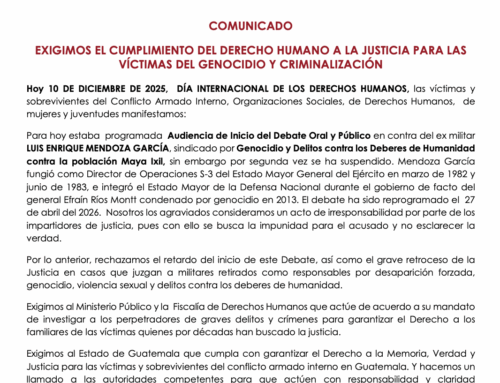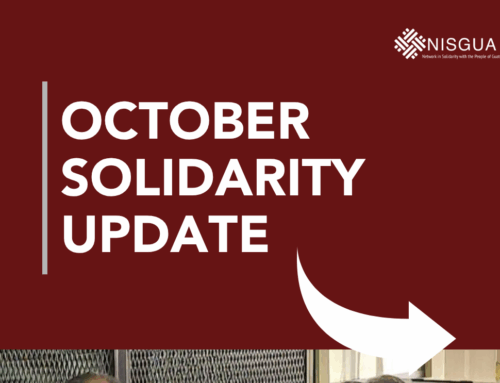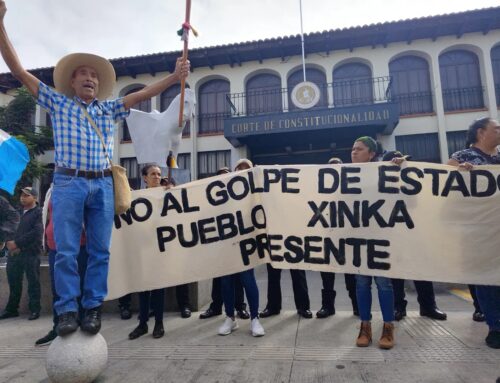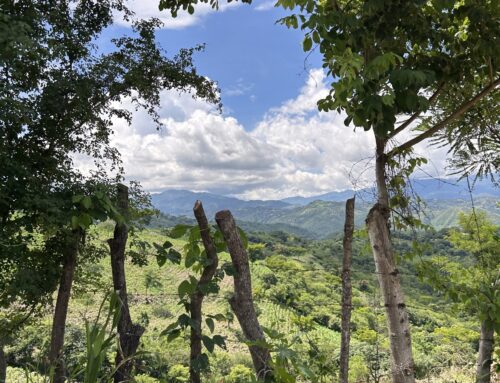Hearings accompanied by AJR Rabinal region
Monday May 6th, 2024
- Diego Avilés Toma, Cajixay, San Juan Cotzal
Witness Diego Avilés recounted that his village was burned by elements of the Guatemalan army on January 8, 1982. The witness heard shouts that the army was coming and he hid in his cornfield, from where he could observe the soldiers burning about 70% of the houses in his community. That day they killed his uncle Antonio Toma and his uncle’s wife Juana Córdova. They have now been exhumed.
The witness indicated that there were guerrillas in the community and that some people were forced to collaborate with food. However, he mentioned that in the massacre only the civilian population was killed.
The witness and his family stayed in the cornfield until January 20, 1982, when the Catholic president of the community, whose last name was Toma Zambrano, found them and made them go to the Cotzal military base. The aforementioned Toma Zambrano handed over a list of people’s names to the army. The witness declared that he was detained, accused of having shot at a helicopter and was thrown into a hole of three to four meters in the base along with other people: “they poured water, urine or human excrement on us. I lived it, I’m not lying.”
Later, they tied him to a pole and continued torturing him in a water well. After the torture, a lieutenant passed by and recognized him, because the witness had previously served in the military in Jutiapa. The lieutenant asked him why he was there and he answered that he had been falsely accused. They took him out and went to the mountains of Cajixáy, he was forced to collaborate with the army looking for the guerrillas.
The witness said that on January 31, 1982, the soldiers again summoned the people of the village and there his father, Miguel Avilés, and his brothers Juan and Domingo and other neighbors, who were falsely betrayed, died.
- María Poma, 86 years old,Cajixay, San Juan Cotzal
The witness, mother of the earlier witness Diego Avilés, recounted that the soldiers killed her husband and two sons. She also noted that Juan Toma Zambrano denounced her sons to the army, and only Diego survived.
According to Toma, this person accused several people in the community, not only to the soldiers but also to the guerrillas. Many people were kidnapped at night because they were accused by him. “Many know that it was he who had their relatives killed but they are afraid to say so,” Toma said.
“It’s not like now, when we use our authorities to find solutions. At that time, it was just to kill us.”
When her husband and children were exhumed she realized that their hands were tied and there were shell casings in the grave. “I don’t know the reason, but this is what happened to them,” she said.
- Roberto Acabal, 68 years old, Estrella Polar, Chajul
The witness narrated that he was in the Estrella Polar massacre, where he saw how the army massacred 96 people and abused women all in one day, on March 23, 1982. “In the place where I lived, we are all survivors. We are all victims,” he said.
The witness recounted that the soldiers fired a shot as they entered the community. It was coffee harvest time, so many people were awake. The soldiers went to the houses to tell them that there would be a meeting and separated the men and women.
The witness hid in his cornfield from where he was able to observe how they killed the men outside the church. He said that the soldiers ate the livestock of people from the community and that they let the women out of the room where they had been locked up, although, he said, they had to cross the river and many drowned. He also indicated that in the Estrella Polar massacre, 2 of his wife’s brothers died.
He had to take refuge in the mountains, where his newborn son, who has not yet been exhumed, died. His life in the mountains was like that of other witnesses that have been heard, continuously pursued by the soldiers, moving from one area to another, being bombed: “The soldiers wanted to finish all the people, to kill all the poor people”.
When asked about the legal action for which he was appearing in court today, Don Roberto replied: “For all the hardships we went through, we have to resort to the law. There are widows left behind who can no longer be taken care of, orphaned children, because of everything they did to us, just for being Indigenous. The people who suffered through this harm are very worn out, very pained all day long.”
- Domingo Caminal, 68 years old, Cajixay, San Juan Cotzal
Witness Domingo Caminal recounted his capture by members of the Guatemalan army while he was working on the highway on January 20, 1982. The witness recounted that the soldiers tied him up and took him to two military bases where he suffered torture. In the first one they kept him in a hole for two days, deprived of food and water and in the other base he was forced to work clearing a forest, and when he finished they let him go.
The witness also explained how an army informant pointed out about 30 villagers in Cajixay, so that the soldiers would kill them with guns, while the people had their hands tied behind their backs. “Well into the night, the soldiers threw the people in a hole and covered them with dirt. Then they went to the base.”
The witness ended as follows: “No one forced me to come here, I come with faith to tell what happened to me. I ask for justice.”
Tuesday May 7th, 2024
- Juana Córdoba, 73 years old, Cajixay, San Juan Cotzal
Witness Juana Córdoba, said that in February 1982, members of the Guatemalan army burned her house, her crops, and killed some of her animals and stole others. That day, the army summoned the neighbors to present them with a flag, and she did not go to the meeting, and stayed home with her 6 children, several of them small. Her husband went to the activity, but never returned.
Later, neighbors told the witness that the army shot her husband and left him buried in a mass grave, along with three of her neighbors. His remains were later exhumed from a mass grave in the Xolotzinay military base and they were able to bury him.
The witness asked the court the following: “I am going to ask that justice be done, because it is not fair that they have done all this to us. It was them who ruined our lives.”
- María Sánchez Córdoba, Cajixay, San Juan Cotzal
The witness testified about the forced disappearance of her husband on January 20, 1982. She said that the paramilitary patrol (PAC’s) with their faces covered came to her house around four o’clock in the morning and took her husband with his hands bound to the military base; from that day on she never saw him again. The witness reported that she went to look for her husband at the Xolotzinay base on several occasions, but they never let her in. Her husband was never accused of any crime.
The witness related that a survivor who had also been illegally detained at the military base told her that her husband was thrown into a pit at the base.
The army also killed her younger brother Diego Sanchez Cordoba and 4 others. Both her brother and her husband were exhumed in different graves at the military base. The witness indicated that it was a neighbor who accused her relatives to the army, but he was also the one who asked for “collaborations” for the guerrillas and also accused people to them.
- Pre-Hearing Testimony, Rosario Pérez de Nebaj.
The witness said that one morning a boy arrived warning that the army was nearby. Her family ran out and the army burned everything in their house. In addition, the army killed her son. After that her family went to another community, but the soldiers arrived there, and grabbed and killed several neighbors.
Wednesday May 8th, 2024
In this hearing, expert statements were heard.
The first expert Mirna Graciela Díaz ratified her forensic anthropology expert testimony on the exhumation of a skeleton in the community of Salquil, Nebaj. With her analysis, she was able to determine that the victim was male, over 50 years old, and was shot in the back.
The expert Maynor Adán Silvestre Aroch ratified 5 forensic anthropology reports, among them one carried out in Sumal 2, Nebaj, for the exhumation of 15 skeletons located in a mass grave. The grave was located on private land and was located with the support of the victims’ families. Of the total number of remains, 7 were of children under 11 years old and 4 were infants. Most were female victims.
Silvestre Aroch ratified another expert report for the exhumation of a skeleton in a clandestine grave, where a baby between 1 and 2 years old was found, and identified by his parents. Prior to the exhumation, the parents said that they fled to the mountains because of the massacres in their village; while there, the army chased them and, as they were fleeing, the baby fell to the ground. When his parents returned to look for him they found him strangled.
The third expert Rolando Melgar Valenzuela ratified his expert report on “Patterns in the Ixil Area”, based on forensic anthropology investigations. The expert explained that they conducted 25 investigations which showed that 95% of the documented deaths were direct and violent, some with evidence of torture prior to execution. The other 5% were indirect deaths caused by forced displacement. The age range of the infant victims was found to be between 0 and 11 years old.
This expert analyzed the cases of 188 victims, of which 159 were women. In another expert analysis, he determined that out of 26 skeletons, 20 were women with signs of sexual violence; the rest corresponded to 3 men and 3 undetermined. According to the expert, the most used means of death was the gunshot in the “cranio-mandibular” area, which evidences the intention of execution. He also concluded that fire was used to burn houses as well as people.
Another pattern was “deception”, because the army called people to meetings, when what they really intended was to massacre the population. He responded that based on the interviews conducted, it was established that the violent deaths were caused by members of the army.
The expert showed the Public Prosecutor a graph explaining that the period of General Lucas Garcia’s government was the most violent and the one in which the most Ixil people were killed.
Thursday May 9th, 2024
Several expert opinions were presented at this hearing. First, the expert Michelle Ojeda, a genetic scientist, who ratified her expert testimony in forensic genetics. She explained to the prosecution that she worked on the identification of 16 skeletons related to the case.
Later, the expert Sergio Oswaldo Garcia Lopez ratified his forensic anthropology expert testimony, related to the exhumation of 4 persons that were found in different clandestine graves. Also, metal fragments were found in the skeletons, related to firearm projectiles.
Report made with notes of hearings and information from Verdad y Justicia and FGER.





Leave A Comment